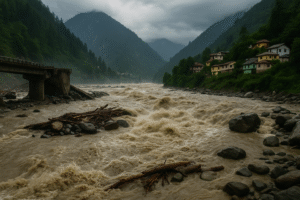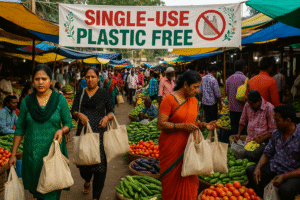Fun Fact: A single mature tree can absorb up to 22 kilograms of carbon dioxide (CO₂) per year—but we emit over 36 billion tonnes annually!
It sounds like a magical fix: plant enough trees, and we can erase our climate sins. Politicians promise it, corporations flaunt it, and environmental campaigns champion it. But is the future of forests really our golden ticket to solving climate change?
The phrase “tree-planting” has become shorthand for climate action. Yet, behind the greenery lies a tangled mess of science, economics, and unintended consequences. As wildfires rage, ecosystems collapse, and the clock ticks toward climate tipping points, it’s time to ask: Can we really rely on planting trees to fix climate change—or are we just outsourcing our guilt to the forest?
Why Tree-Planting Is So Popular
Tree-planting hits all the right notes: it’s cheap, photogenic, and feel-good. From government schemes in India’s Uttar Pradesh to billion-tree pledges from tech giants, afforestation (planting trees where there were none before) and reforestation (replanting cleared forests) are in vogue.
Take the Trillion Tree Campaign, backed by the World Economic Forum, which aims to plant one trillion trees globally. Or consider companies like Ecologi, a UK-based platform that lets individuals and businesses fund tree-planting to offset their carbon footprint. It’s climate action with the click of a button.
In India, the Green India Mission—part of the National Action Plan on Climate Change—aims to increase forest cover and enhance ecosystem services. Corporates too have jumped in; Wipro Ltd., a major Indian tech company, has funded afforestation drives in multiple states as part of its sustainability initiatives.
The appeal is clear: trees absorb carbon dioxide (CO₂), the main greenhouse gas responsible for global warming. They also cool cities, prevent soil erosion, and support biodiversity. So what’s the problem?
The Hidden Pitfalls of Mass Tree-Planting
Not All Trees Are Equal
Monoculture plantations—planting a single species over vast areas—might look green on satellite maps, but they’re ecological deserts. Fast-growing species like eucalyptus or pine are often chosen for quick wins, but they consume massive amounts of water and support little biodiversity.

In Mizoram, a northeastern Indian state, monoculture plantations under compensatory afforestation laws have displaced native forests and tribal livelihoods. What’s more, such plantations often store less carbon than natural forests and may become fire-prone.
The Land Problem
Where will we plant all these trees?
A study published in Science in 2019 proposed that Earth could support an additional 900 million hectares of tree cover—about the size of the United States. But critics quickly pointed out that much of this land is already in use for agriculture or grazing.
In India, where land conflicts are already common, tree-planting initiatives have sometimes led to encroachments on community commons or tribal lands, sparking protests. Planting trees in the wrong places—like grasslands or wetlands—can actually harm local ecosystems.
Carbon Accounting Illusions
Trees take time to grow. A sapling planted today may take decades to absorb meaningful amounts of carbon—assuming it survives droughts, fires, pests, and human activity.
Yet, many carbon offset schemes count emissions reductions immediately, creating a dangerous illusion of progress. This is a particularly thorny issue for corporate “net-zero” pledges, where companies continue emitting CO₂ under the pretence that trees somewhere else will absorb it.
A 2023 investigation by The Guardian and Die Zeit revealed that many rainforest carbon offsets were “largely worthless”—the trees weren’t preventing any real emissions.
When Tree-Planting Works
This doesn’t mean tree-planting is useless. Far from it. When done right, it can be an essential tool in our climate toolkit.
In Maharashtra, the Sahyadri Nisarga Mitra group has worked with local communities to restore degraded forest land using native species. The results: better soil retention, more local water sources, and real carbon sequestration.
In Ethiopia, reforestation programs have not only reduced erosion but also empowered rural communities through agroforestry—planting trees alongside crops, improving both yield and resilience.
In such cases, trees aren’t just planted and forgotten; they’re nurtured, monitored, and integrated into the local ecology and economy.
Beyond Tree-Planting: The Real Climate Solutions
Here’s the hard truth: no number of trees can absorb emissions at the rate we’re producing them.
Instead, we need to drastically cut emissions at the source—by phasing out fossil fuels, investing in clean energy, transforming our food systems, and rethinking consumption. Forests can support these efforts, but they can’t substitute for them.
Tree-planting, when treated as a silver bullet, becomes a distraction. Worse, it becomes a license to delay meaningful change.
It’s like trying to mop up water from a running tap without turning off the faucet.
What You Can Do (Beyond Planting a Tree)
Support Indigenous and community-led conservation. These groups often protect forests better than state-run schemes.
Avoid offset gimmicks. Focus instead on reducing your own carbon footprint.
Vote and advocate. Demand climate accountability from leaders and corporations.
Choose native plants if you do plant. Avoid fast-growing, non-native species unless carefully planned for agroforestry or fire control.
Stay informed. Climate action begins with climate education.
Conclusion: The Forest Can’t Do It Alone
The notion of planting trees to combat climate change feels comforting—it’s straightforward, eco-friendly, and full of hope. But it’s also dangerously seductive. The climate crisis is not a gardening problem; it’s a systems problem.
Tree-planting has its place, but it’s not a get-out-of-jail-free card for polluters. If we treat it as such, we’re not saving forests—we’re hiding behind them.
Let’s stop outsourcing climate responsibility to trees and start taking it ourselves.
Author’s Note
This article is not an anti-tree manifesto. Forests are vital, and planting the right tree in the right place for the right reason can do wonders. But it’s time we confront the comforting myths we tell ourselves about climate solutions. Sometimes, the easiest solution isn’t the most honest one.
G.C., Ecosociosphere contributor.
References and Further Reading
- Bastin et al. (2019). The global tree restoration potential. Science. https://science.org/doi/10.1126/science.aax0848
- The Guardian: Revealed: more than 90% of rainforest carbon offsets by biggest certifier are worthless, analysis shows https://www.theguardian.com/environment/2023/jan/18
- Mongabay India: India’s afforestation efforts leave communities in the lurch
- Yale Environment 360: The Case Against Planting Trees in Grasslands https://e360.yale.edu/features/the-case-against-planting-trees-in-grasslands
- Sustainable development goals (SDGs): A blueprint for global progress. https://en.moniflo.com/blog/ziele-fur-die-nachhaltige-entwicklung-sdg-ein-konzept-fur-den-globalen-fortschritt
- About Rainforest Rangers – Rainforest Rangers. https://www.rainforestrangers.org/about-rainforest-rangers
- How to capture and use atmospheric CO₂. https://www.chemeurope.com/en/news/1163609/how-to-capture-and-use-atmospheric-co.html
- Sustainability: Carbon Offsets – Fact or Fiction – The Sandpiper. https://delmarsandpiper.org/2024-02-008/





Comments
Great insights! This really gave me a new perspective. Thanks for sharing.